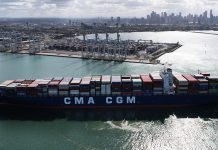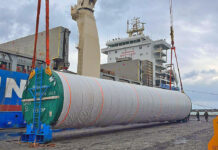
Incheon Port Authority and HMM are working together to attract more gateway container cargoes from the US and Canadian west coasts.
The South Korean port authority said on 29 May that its vice-president (operations), Kim Jong-gil, and HMM representatives, had met with major shippers in the United States and Canada, as well as the Port of Los Angeles’ trade development director Marisela Caraballo DiRuggiero and director of cargo marketing, Eric Caris.
These shippers include a US paper exporter and a logistics company handling frozen food shipments for more than 110 US and Canadian specialty food retailers.
Incheon is the main gateway into the Seoul metropolitan area while HMM, South Korea’s flagship box line, provides the only container liner service between the port and the Americas.
HMM reportedly indicated that it would consider receiving major food items through Incheon Port. This is expected to reach about 50,000 TEUs per year.
Incheon Port Authority’s representatives are planning to meet officials from a US paper exporter in the Namdong and Sihwa Industrial Complexes in early July to expand the volume of goods transported through the port.
The authority said that container volumes on the Incheon-North America route declined from 2021 to 2022 due to supply chain bottlenecks caused by the Covid-19 pandemic, but since then, congestion has been resolved and freight rates are stabilising.
Incheon Port processed 3.19 million TEUS in 2022, down 5% from 3.35 million TEUS in the previous year.
Accordingly, Incheon Port Authority decided to work with HMM to market the port, highlighting reduced logistics costs for cargoes to and from the Seoul metropolitan area.
Kim said that during the meeting with DiRuggiero and Caris, they discussed environmental policies for both ports, including carbon neutrality at Los Angeles, and to develop mutual shipper-matching activities and export/import support schemes for Incheon Port and Los Angeles Port.
“Through this port sales, we were able to publicise Incheon Port in various ways and strengthen our network, including hinterland complexes, cold chain clusters, and Incheon New Port Phase 1-2 container terminals,” noted Kim.
Martina Li
Asia Correspondent





